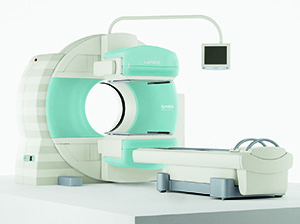
Nuclear Medicine, also known as molecular radiology, is a medical specialty that uses radioactive tracers (radiopharmaceuticals) to assess bodily functions and to diagnose and treat disease. Different radiopharmaceuticals go to different tissues within the body depending on presence of dysfunction, injury, or disease. Some radiopharmaceuticals also actively target and treat disease. Specially designed cameras allow doctors to track the path of these radioactive tracers. Planar gamma imaging, Single Photon Emission Computed Tomography (SPECT), and Positron Emission Tomography (PET) scans are among the most common imaging modalities in nuclear medicine.
The Society of Nuclear Medicine and Molecular Imaging (SNMMI) provides resources to learn more about how this dynamic specialty can help patients with cancer, heart disease, neurological disease, and many other diseases.
Diagnostic Procedures
Gallbladder problems can be diagnosed using hepatobiliary iminodiacetic acid (HIDA) scans thyroid disease
Lymphoscintigraphy uses small amounts of radioactive material to identify the sentinel lymph node to plan a biopsy or surgery. This will help assess the stage of cancer and create a treatment plan or identify points of blockage in the lymphatic system, such as lymph flow in an arm or leg, or lymphedema.
Therapeutic Procedures
Radioimmunotherapy in which a radioactive element is tagged to an antibody that targets a specific cancerous cell.
Thyroid Ablation.
PET scans
PET scans are used to obtain more data regarding how body organs are functioning. PET scans may be performed together with a computerized axial tomography (CT) scan that provides an image of the organ. PET scans provide a clear view of how the organs are working at the cellular level and if they have been damaged. The scan helps doctors determine effective treatment options. PET scans are commonly used to diagnose heart conditions, help doctors determine appropriate cancer treatment, help in diagnosing Alzheimer’s disease and brain disorders. They also can provide data for medical research.
For more information about any/all of these procedures, go to radiologyinfo.org




